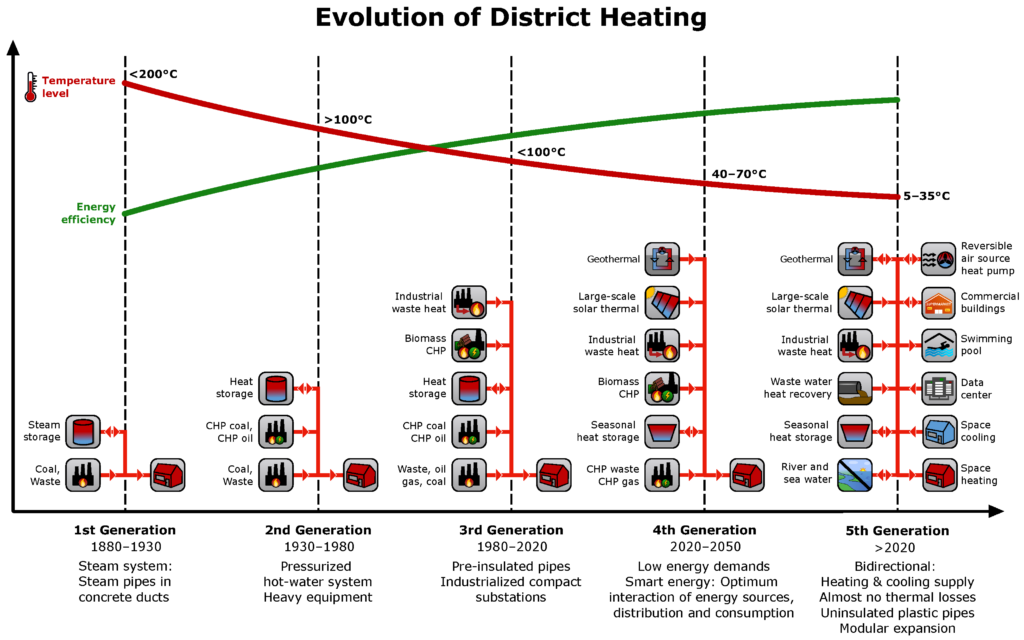Thermal Energy is an abundant source of renewable energy all around us that is measured in temperature. Wastewater systems, energy-intensive buildings, bodies of water, and even the ground beneath our feet contain heat that can be harnessed with heat pumps and transferred in and out of buildings to provide heating and cooling. Like wind and solar energy, thermal energy is a renewable energy resource that can be harnessed to create an emissions-free built environment.
Thermal Energy Networks are heating and/or cooling systems where buildings share thermal energy via ambient water pipes and use a non-combusting, non-emitting energy source such as geothermal or waste heat. In a thermal energy network, every building on the network will need a ground source or water source heat pump. Thermal energy networks are designed opportunistically to use the resources of the location.
Clean Thermal Energy Networks (CTENs) is a thermal network without combustion. District energy systems that pipe steam can be considered “clean” if the steam is created by heating water with renewable energy such as deep geothermal or highly efficient electric equipment such as heat pumps, but not if combustible fuels (e.g. a gas power plant) are used to create the steam.
Utility Thermal Energy Networks (UTENs) are networks built and maintained by utilities (gas, electric, or water). Currently, private and public organizations can build and operate TENs, only utilities are not allowed unless they are given legislative or regulatory approval.
District Energy Systems generate heat in a centralized location that is distributed through underground piping to deliver heating and cooling to residential and commercial consumers. The heat is often obtained from a cogeneration plant burning fossil fuels but can also be generated through industrial-scale electric heat pumps. More recently, it has become more common for the central plant energy source to be renewable, e.g. geothermal.
District energy systems have been around for over 100 years. They have evolved over time, with efficiency improving alongside each new technological iteration. First generation systems were steam-based and fueled by coal.

Figure 1. Visualisation of the evolution of district heating and cooling networks, from the 1st to the 5th generation of DHC networks [24]. Source: Wirtz, M.; Kivilip, L.; Remmen, P.; Müller, D. Quantifying Demand Balancing in Bidirectional Low Temperature Networks. Energy Build. 2020, 224, 110245
The latest generation (5th generation) district heating and cooling networks have similar characteristics to thermal energy networks including the addition of heat pumps in every building on the network to extract and reject heat to an ambient temperature water loop.
Other terms for Thermal Energy Networks: networked geothermal, geogrids, geo-exchange, district thermal, community heat pumps networks, community thermal networks, heat networks, heating and cooling networks
Other terms used for Geothermal Networks: networked geothermal, networked ground-source heat pumps, geothermal micro districts, GeoMicroDistricts, community-style heat pump systems, community heat pumps, CommunityGeo, GSHP communities, geo-exchange systems
Thermal Energy is an abundant source of renewable energy all around us that is measured in temperature. Wastewater systems, energy-intensive buildings, bodies of water, and even the ground beneath our feet contain heat that can be harnessed with heat pumps and transferred in and out of buildings to provide heating and cooling. Like wind and solar energy, thermal energy is a renewable energy resource that can be harnessed to create an emissions-free built environment.
Thermal Energy Networks are heating and/or cooling systems where buildings share thermal energy via ambient water pipes and use a non-combusting, non-emitting energy source such as geothermal or waste heat. In a thermal energy network, every building on the network will need a ground source or water source heat pump. Thermal energy networks are designed opportunistically to use the resources of the location.
Clean Thermal Energy Networks (CTENs) is a thermal network without combustion. District energy systems that pipe steam can be considered “clean” if the steam is created by heating water with renewable energy such as deep geothermal or highly efficient electric equipment such as heat pumps, but not if combustible fuels (e.g. a gas power plant) are used to create the steam.
Utility Thermal Energy Networks (UTENs) are networks built and maintained by utilities (gas, electric, or water). Currently, private and public organizations can build and operate TENs, only utilities are not allowed unless they are given legislative or regulatory approval.
District Energy Systems generate heat in a centralized location that is distributed through underground piping to deliver heating and cooling to residential and commercial consumers. The heat is often obtained from a cogeneration plant burning fossil fuels but can also be generated through industrial-scale electric heat pumps. More recently, it has become more common for the central plant energy source to be renewable, e.g. geothermal.
District energy systems have been around for over 100 years. They have evolved over time, with efficiency improving alongside each new technological iteration. First generation systems were steam-based and fueled by coal.

Figure 1. Visualisation of the evolution of district heating and cooling networks, from the 1st to the 5th generation of DHC networks [24]. Source: Wirtz, M.; Kivilip, L.; Remmen, P.; Müller, D. Quantifying Demand Balancing in Bidirectional Low Temperature Networks. Energy Build. 2020, 224, 110245
The latest generation (5th generation) district heating and cooling networks have similar characteristics to thermal energy networks including the addition of heat pumps in every building on the network to extract and reject heat to an ambient temperature water loop.
Other terms for Thermal Energy Networks: networked geothermal, geogrids, geo-exchange, district thermal, community heat pumps networks, community thermal networks, heat networks, heating and cooling networks
Other terms used for Geothermal Networks: networked geothermal, networked ground-source heat pumps, geothermal micro districts, GeoMicroDistricts, community-style heat pump systems, community heat pumps, CommunityGeo, GSHP communities, geo-exchange systems
